From an article by Colonels Sterling A. Wood and Roy N. Hagerty as published in the Infantry Journal, May 1942
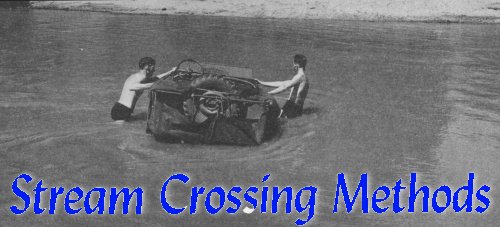 The original question was how to float a jeep. With further research I came across an article in the Infantry Journal, May 1942 that covered just that. Of course you can also use cable elevated high enough for the jeep to clear the water and run it across that way as well. What follows is the work of Cols. Wood and Hagerty. The original photos form the article appear to all be of the Bantam and one of the first 70 vehicles at that as the jeep display has the rounded nose hood. Additional photos have been edited from the Nothing but WW2 Jeeps DVD available from Vintage Video.
All fighting units need to know a number of stream crossing expedients for use when the standard stream crossing equipment (bridges, pontons, boats) is not on hand, which will often happen in action. In order to get the maxinium benefit from the training in these expedients. commanders should limit the gear used to equipment and materials that are of standard issue or that troops may reasonably expect to find on the scene of actual operations.
In its early phase the training should be conducted at a quiet pond or lake or at a stream with a slow curent. Crossing operations on streams with strong currents are difficult and there is much danger of injury to men and equipment. Practice over swift streams should come later after the men have had experience in quiet waters and know what to expect and how to deal with it.
Different kinds of floats can he used but the volume of any float should be made as large as practicable to insure maximum water displacement and a high freeboard. The center of gravity of floating bundles, particularly those floating large vehicles should be kept as low as practicable to prevent capsizing.
In general the construction of wooden rafts is uneconomical in time and labor. Other expedients do the job as well and much more easily and quickly.
A safety-line stretched across the stream downstream from the crossing site is useful, when free floats are being crossed, to catch unmanageable floats carried downstream by the current. The ¾ inch rope in the infantry pioneer equipment and truck-winch cables are useful here. If a winch-truck can be crossed early in the operation it will be a big help in pulling other floats across and in beaching heavy equipment.
Each load being floated should have a rope or cable attached to it with a buoyant object such as a stick or log tied to the loose end which will rise to the surface and mark the location of the cargo in case of accidental sinking. This line should be strong and attached so as to make salvage a simple job.
Other than the large paulins used to float trucks larger than the quarter-ton truck, the stream-crossing methods described here only require equipment and materials usually on hand within an infantry regiment or materials usually found at a crossing site. The major items of equipment and materials needed are:
The original question was how to float a jeep. With further research I came across an article in the Infantry Journal, May 1942 that covered just that. Of course you can also use cable elevated high enough for the jeep to clear the water and run it across that way as well. What follows is the work of Cols. Wood and Hagerty. The original photos form the article appear to all be of the Bantam and one of the first 70 vehicles at that as the jeep display has the rounded nose hood. Additional photos have been edited from the Nothing but WW2 Jeeps DVD available from Vintage Video.
All fighting units need to know a number of stream crossing expedients for use when the standard stream crossing equipment (bridges, pontons, boats) is not on hand, which will often happen in action. In order to get the maxinium benefit from the training in these expedients. commanders should limit the gear used to equipment and materials that are of standard issue or that troops may reasonably expect to find on the scene of actual operations.
In its early phase the training should be conducted at a quiet pond or lake or at a stream with a slow curent. Crossing operations on streams with strong currents are difficult and there is much danger of injury to men and equipment. Practice over swift streams should come later after the men have had experience in quiet waters and know what to expect and how to deal with it.
Different kinds of floats can he used but the volume of any float should be made as large as practicable to insure maximum water displacement and a high freeboard. The center of gravity of floating bundles, particularly those floating large vehicles should be kept as low as practicable to prevent capsizing.
In general the construction of wooden rafts is uneconomical in time and labor. Other expedients do the job as well and much more easily and quickly.
A safety-line stretched across the stream downstream from the crossing site is useful, when free floats are being crossed, to catch unmanageable floats carried downstream by the current. The ¾ inch rope in the infantry pioneer equipment and truck-winch cables are useful here. If a winch-truck can be crossed early in the operation it will be a big help in pulling other floats across and in beaching heavy equipment.
Each load being floated should have a rope or cable attached to it with a buoyant object such as a stick or log tied to the loose end which will rise to the surface and mark the location of the cargo in case of accidental sinking. This line should be strong and attached so as to make salvage a simple job.
Other than the large paulins used to float trucks larger than the quarter-ton truck, the stream-crossing methods described here only require equipment and materials usually on hand within an infantry regiment or materials usually found at a crossing site. The major items of equipment and materials needed are:
- Canvas paulin, 20 feet 6 inches x 40 feet (not issued to infantry units)
- Canvas cover, 2-½-ton truck, 14 feet 6 inches x 14 feet 8 inches
- Canvas cover, 1-½-ton truck, 11 feet 4 inches x 13 feet 11 inches
- Canvas cover, ½-ton truck, 8 feet x 13 feet 11 inches
- Shelter half
- Inner tubes, from truck tires
- Saplings and brush
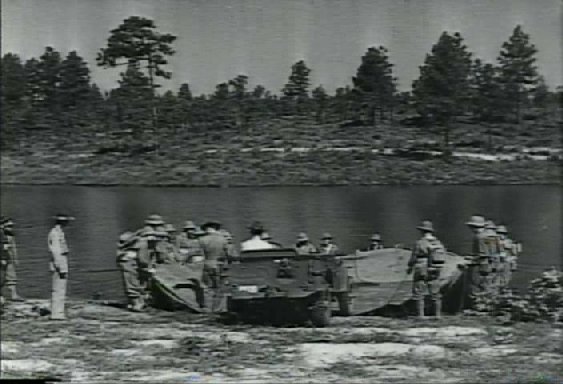 The quarter-ton truck with normal load (including men) can be launched, floated across a stream, and beached, if both stream banks slope gently. Four men can do the job using any of the following methods:
First wet the bank at the site of the launching in order to make it easy to slide the truck into the stream. Then spread the canvas cover of a 2-1/2-ton truck on the bank at the water’s edge and drive the quarter-ton truck onto the center of the canvas.
The quarter-ton truck with normal load (including men) can be launched, floated across a stream, and beached, if both stream banks slope gently. Four men can do the job using any of the following methods:
First wet the bank at the site of the launching in order to make it easy to slide the truck into the stream. Then spread the canvas cover of a 2-1/2-ton truck on the bank at the water’s edge and drive the quarter-ton truck onto the center of the canvas.
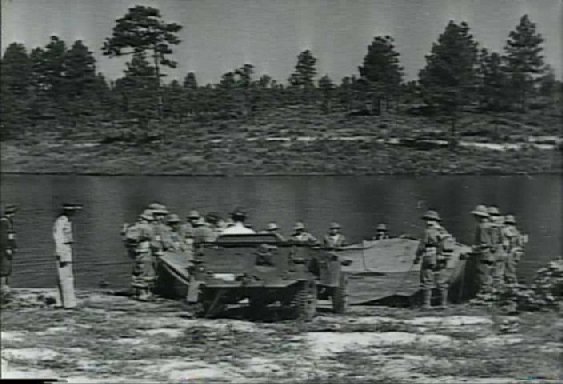 Raise the edges of the canvas at the front and rear of the truck and fasten the short tie ropes to convenient points on the truck. Next raise the edges of the canvas at the sides of the truck and tighten the drawropes about the sides of the truck and tie them, but be careful that the canvas is not folded sharply at the ends (like a clerk does in wrapping a shoe box) because the canvas may leak at the creases.
Raise the edges of the canvas at the front and rear of the truck and fasten the short tie ropes to convenient points on the truck. Next raise the edges of the canvas at the sides of the truck and tighten the drawropes about the sides of the truck and tie them, but be careful that the canvas is not folded sharply at the ends (like a clerk does in wrapping a shoe box) because the canvas may leak at the creases.
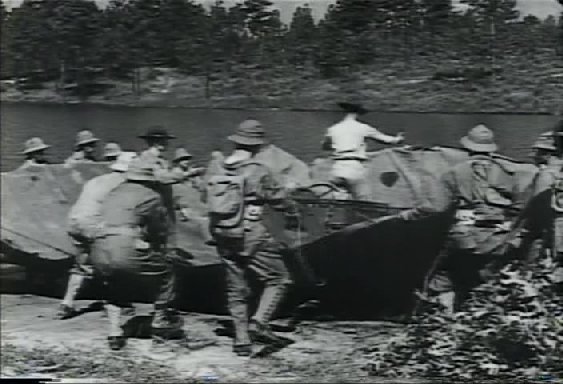 Four men can slide the wrapped vehicle with its normal load of equipment into the water. It will float easily if correctly wrapped and tied.
Four men can slide the wrapped vehicle with its normal load of equipment into the water. It will float easily if correctly wrapped and tied.
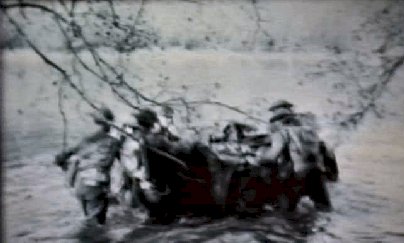
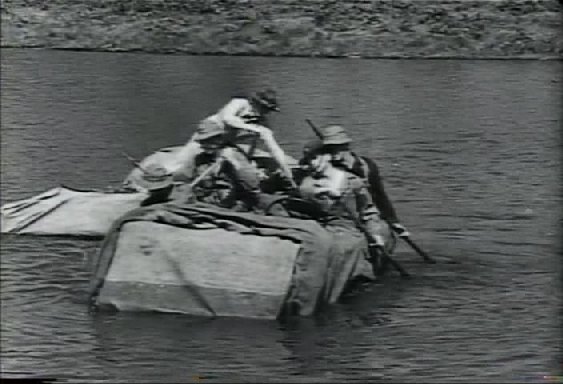 There are several ways of getting the vehicle across, the method used depending more or less on the depth and current. If the stream is not too deep the men can push it across by wading; it can be poled across by three or four men sitting in the vehicle using saplings or paddled across by three or Four men sitting in the vehicle using shovels as paddles. It can be towed across by using a light towing line such as a field telephone wire which is first stretched across the stream by a swimmer; towed across by running the cable of a truck winch on the near side of the stream through a snatchblock attached to a tree on the far side, thence back to the floating vehicle or pulled across (hand over hand) by men on the vehicle; or along a rope or cable stretched across the stream and anchored at both ends.
When the vehicle reaches the gently sloping bank on the far side of the stream, untie the ropes of the cover, drop the canvas and drive the vehicle out under its own power.
There are several ways of getting the vehicle across, the method used depending more or less on the depth and current. If the stream is not too deep the men can push it across by wading; it can be poled across by three or four men sitting in the vehicle using saplings or paddled across by three or Four men sitting in the vehicle using shovels as paddles. It can be towed across by using a light towing line such as a field telephone wire which is first stretched across the stream by a swimmer; towed across by running the cable of a truck winch on the near side of the stream through a snatchblock attached to a tree on the far side, thence back to the floating vehicle or pulled across (hand over hand) by men on the vehicle; or along a rope or cable stretched across the stream and anchored at both ends.
When the vehicle reaches the gently sloping bank on the far side of the stream, untie the ropes of the cover, drop the canvas and drive the vehicle out under its own power.
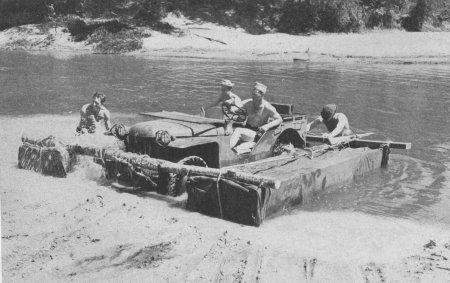 Another way of getting a truck across a stream is to use two box frames made of saplings, each 1 foot 6 inches x 3 feet x 11 feet. The saplings should be notched and lashed together with small ropes or short lengths of field-telephone wire. Each frame is then wrapped in the canvas top of either a 2-½-ton truck, or a 1-½-ton truck, which makes improvised pontons of them. The canvas is held in place by ropes tied around the ponton.
The quarter-ton truck is driven to the waters edge between the two pontons. Large saplings are securely lashed, horizontally, to the front and rear bumpers, with the ends of the saplings extending along the sides of the vehicle and above the ends of the pontons. The pontons are then securely lashed to these cross pieces, thus raising them a few inches off the ground. Disconnect the fanbelt of the truck so that the motor won’t be flooded and drive the truck into the stream under its own power.
Another way of getting a truck across a stream is to use two box frames made of saplings, each 1 foot 6 inches x 3 feet x 11 feet. The saplings should be notched and lashed together with small ropes or short lengths of field-telephone wire. Each frame is then wrapped in the canvas top of either a 2-½-ton truck, or a 1-½-ton truck, which makes improvised pontons of them. The canvas is held in place by ropes tied around the ponton.
The quarter-ton truck is driven to the waters edge between the two pontons. Large saplings are securely lashed, horizontally, to the front and rear bumpers, with the ends of the saplings extending along the sides of the vehicle and above the ends of the pontons. The pontons are then securely lashed to these cross pieces, thus raising them a few inches off the ground. Disconnect the fanbelt of the truck so that the motor won’t be flooded and drive the truck into the stream under its own power.
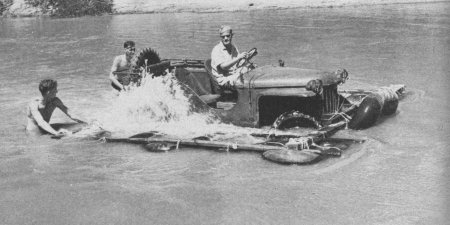 Any of the propulsion methods used to get a wrapped-up truck across a stream will get the ponton job across. Then untie the bumper lashings, take off the front pole, and drive the truck out of the water under its own power. Don?t forget to replace the fan belt.
If the bank of the stream is so steep that the vehicle can’t be driven out of the water under its own power, it may be pulled out by using the winch of a truck emplaced on the near side of the stream, the cable running through a snatchbiock attached to a tree on the far side.
Another type of ponton can be made by constructing two outriggers each consisting of five inner tubes, 9 inches x 20 inches (from 2-½-ton trucks), and two stout saplings (upright poles for the large walltent can be used). The inner tubes are inflated to a pressure of about eight pounds and lashed to the poles. If smaller tubes are used more of them will be needed.
The quarter-ton truck is driven to the water?s edge and the outriggers are placed on the ground, one on each side of the truck. Large saplings (or ridge poles for large walltents) are securely lashed horizontally to the front and rear bumpers, with the ends of the poles extending beyond the sides of the vehicle and above the ends of the outriggers. The outriggers are then securely lashed to these crosspieces. An additional inner tube is lashed under the front bumper of the vehicle to provide flotation for launching.
The fanbelt of the truck is disconnected and the vehicle is driven into the stream under its own power.
Any one of several methods of propulsion may be used and the vehicle is beached as described above.
After beaching, the crosspoles are unlashed from the bumpers and the rigging is lifted by hand over the truck and floated back to receive another vehicle.
Any of the propulsion methods used to get a wrapped-up truck across a stream will get the ponton job across. Then untie the bumper lashings, take off the front pole, and drive the truck out of the water under its own power. Don?t forget to replace the fan belt.
If the bank of the stream is so steep that the vehicle can’t be driven out of the water under its own power, it may be pulled out by using the winch of a truck emplaced on the near side of the stream, the cable running through a snatchbiock attached to a tree on the far side.
Another type of ponton can be made by constructing two outriggers each consisting of five inner tubes, 9 inches x 20 inches (from 2-½-ton trucks), and two stout saplings (upright poles for the large walltent can be used). The inner tubes are inflated to a pressure of about eight pounds and lashed to the poles. If smaller tubes are used more of them will be needed.
The quarter-ton truck is driven to the water?s edge and the outriggers are placed on the ground, one on each side of the truck. Large saplings (or ridge poles for large walltents) are securely lashed horizontally to the front and rear bumpers, with the ends of the poles extending beyond the sides of the vehicle and above the ends of the outriggers. The outriggers are then securely lashed to these crosspieces. An additional inner tube is lashed under the front bumper of the vehicle to provide flotation for launching.
The fanbelt of the truck is disconnected and the vehicle is driven into the stream under its own power.
Any one of several methods of propulsion may be used and the vehicle is beached as described above.
After beaching, the crosspoles are unlashed from the bumpers and the rigging is lifted by hand over the truck and floated back to receive another vehicle.
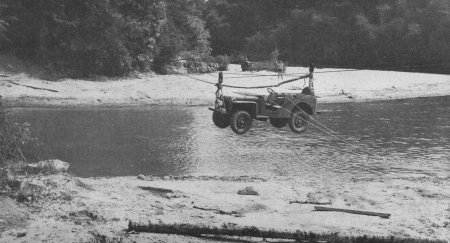 These methods of crossing the quarter-ton truck are not practicable when the current is very swift or the banks are steep and high. Here the aerial cable ferry will be found useful. In constructing a cable ferry it is important to have the ends of the cables anchored as high as possible so that there is considerable slack. Too little slack in the cables may cause enough tension to break them. Since winch-cables are normally 300 feet in length the spans of such cable ferries are limited accordingly.
Two 2-½-ton trucks equipped with power winches are anchored against trees on the high, near bank of the stream. Light ropes or lengths of field-telephone wires are stretched across the stream and tile two winch cables are pulled across with these lines. The cables are secured to stout trees on the far bank at points well above the ground. The cables should be roughly parallel and about twelve feet apart.
A quarter-ton truck is placed under the cables and rigged to snatchblocks by towchains attached to the front and rear bumpers. Slack is taken out of the cables by the winches to raise the vehicle off the ground. A sapling is lashed to the snatchhlocks on the cables to keep the vehicle from swaying while being pulled across the stream. A bridle in the towing line will also prevent sway.
An additional snatchblock is attached to the base of a tree on the far bank. A light towing line is stretched from the near bank through this snatchblock, returned to the near bank and attached to the vehicle. Four men on the near side can then pull the vehicle across.
A quarter-ton truck may be rigged to two snatchblocks placed on a single cable from a 2-½-ton or 1-½-ton truck winch and pulled across in the same fashion.
Picture Sources: Infantry Journal, May 1942
These methods of crossing the quarter-ton truck are not practicable when the current is very swift or the banks are steep and high. Here the aerial cable ferry will be found useful. In constructing a cable ferry it is important to have the ends of the cables anchored as high as possible so that there is considerable slack. Too little slack in the cables may cause enough tension to break them. Since winch-cables are normally 300 feet in length the spans of such cable ferries are limited accordingly.
Two 2-½-ton trucks equipped with power winches are anchored against trees on the high, near bank of the stream. Light ropes or lengths of field-telephone wires are stretched across the stream and tile two winch cables are pulled across with these lines. The cables are secured to stout trees on the far bank at points well above the ground. The cables should be roughly parallel and about twelve feet apart.
A quarter-ton truck is placed under the cables and rigged to snatchblocks by towchains attached to the front and rear bumpers. Slack is taken out of the cables by the winches to raise the vehicle off the ground. A sapling is lashed to the snatchhlocks on the cables to keep the vehicle from swaying while being pulled across the stream. A bridle in the towing line will also prevent sway.
An additional snatchblock is attached to the base of a tree on the far bank. A light towing line is stretched from the near bank through this snatchblock, returned to the near bank and attached to the vehicle. Four men on the near side can then pull the vehicle across.
A quarter-ton truck may be rigged to two snatchblocks placed on a single cable from a 2-½-ton or 1-½-ton truck winch and pulled across in the same fashion.
Picture Sources: Infantry Journal, May 1942
